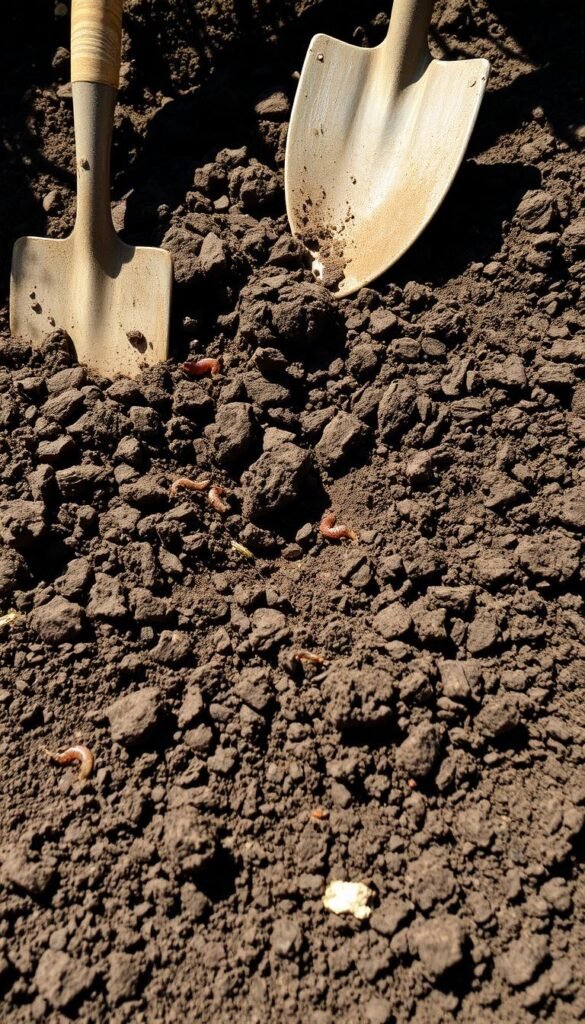Creating a vibrant outdoor space begins with one simple truth: great gardens grow from the ground up. Whether you’re dreaming of colorful blooms or a serene backyard retreat, success hinges on what happens beneath the surface. The secret lies in nurturing strong roots through thoughtful groundwork long before those first petals appear.
Think of soil as your garden’s pantry – it stores all the nutrients plants need to flourish. Properly preparing this foundation helps flowers withstand summer heat, spring rains, and everything in between. A well-tended base creates resilient plants that naturally resist pests and diseases, saving you time and effort down the road.
Many enthusiastic growers make the mistake of rushing to plant without assessing their space. Take inspiration from seasoned gardeners who swear by starting a new flower garden with careful planning. Observe sunlight patterns, test drainage, and consider mature plant sizes to avoid overcrowding later.
This journey transforms your yard through intentional steps that build lasting beauty. From selecting the right blooms for your climate to establishing maintenance routines, every choice matters. With patience and these proven methods, you’ll create an outdoor sanctuary that grows more stunning each season.
Planning Your Flower Garden Location
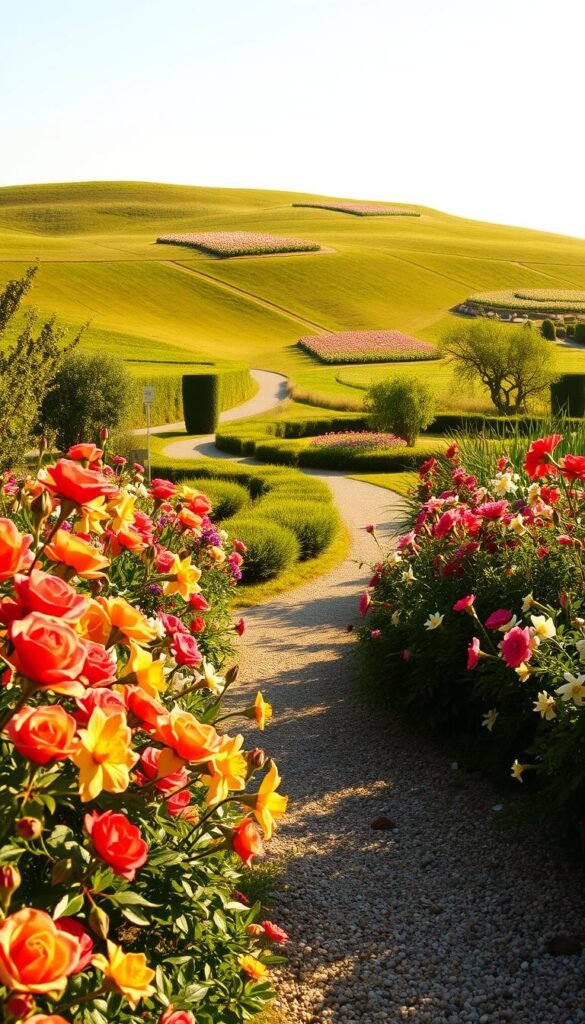
Location determines whether your flowers thrive or just survive. Three factors shape this decision: sunlight patterns, earth quality, and water access. Get these right, and you’ll create a space where roots dig deep and blooms burst with color.
Tracking Light Patterns
Grab a notebook and monitor your chosen area hourly. Full sun spots bask in 6+ hours of direct light – perfect for daisies and lavender. Shady corners suit hostas and ferns. Watch how shadows move across your space as seasons change.
Testing Earth Conditions
Stab a shovel into the ground after rainfall. If water pools for hours or the soil feels like concrete, rethink your spot. Healthy earth crumbles like chocolate cake and drains within minutes. Mix in compost if needed to improve texture.
Water Source Check
Measure the distance from your spigot to the planned beds. Can your hose reach comfortably? Consider installing a rain barrel nearby for dry spells. Plants drink deeply in summer heat – easy access prevents wilted petals.
Think beyond beauty. Could these blooms hide a utility box or frame your front walk? Strategic placement marries practicality with joy, creating spaces you’ll love and use daily.
Preparing the Soil and Garden Beds
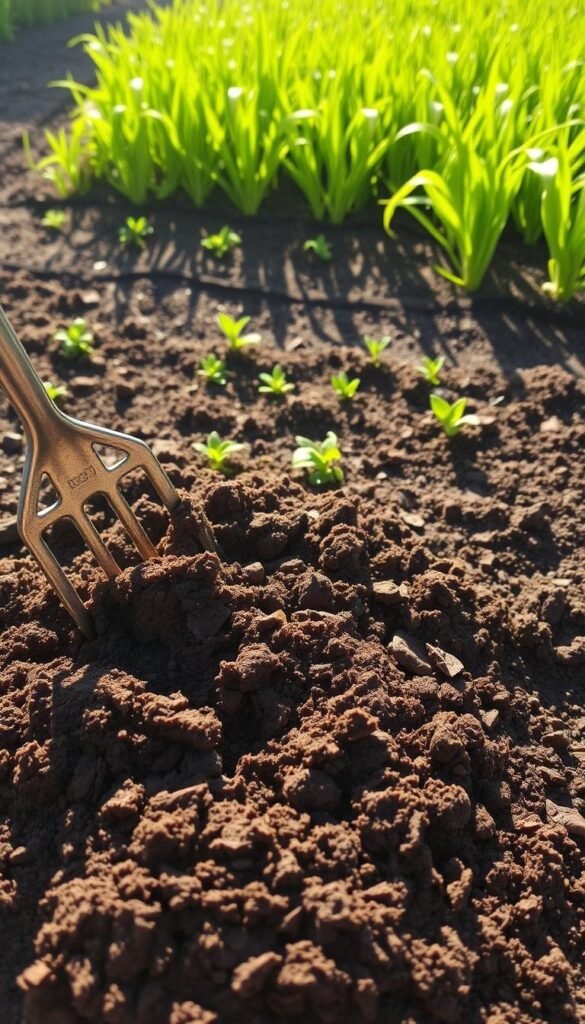
Great gardens begin with earth that breathes. Your soil isn’t just dirt – it’s a living ecosystem hungry for organic matter. Let’s transform your planting areas into thriving environments where roots spread freely and nutrients flow abundantly.
Layering Compost for a Nutrient-Rich Foundation
Start with the newspaper sandwich method for new beds. Alternate 5-6 sheets of plain newsprint with 2-3″ of compost like stacking lasagna layers. This natural weed barrier:
- Blocks sunlight from unwanted grasses
- Decomposes into plant food by spring
- Invites earthworms to aerate your beds
Choose compost with visible wood chips and leaf fragments – these slow-release materials maintain soil structure better than powdery mixes. Mix thoroughly into the top 18″ using the double-dig method for maximum root space.
Removing Existing Vegetation Effectively
Timing matters when clearing established beds. Perform the squeeze test: grab a handful of earth and press firmly. Perfect soil crumbles like coffee grounds, while soggy dirt needs drying time.
“Feed the soil, not just the plants” – this golden rule applies whether you’re refreshing old beds or creating new ones.
For areas with existing perennials, work compost around plants using a hand fork. Remove weeds by their roots on dry days when soil releases them easily. Always leave cleaned beds slightly mounded to prevent water pooling.
How to Start a Flower Garden: From Soil Preparation to Plant Selection
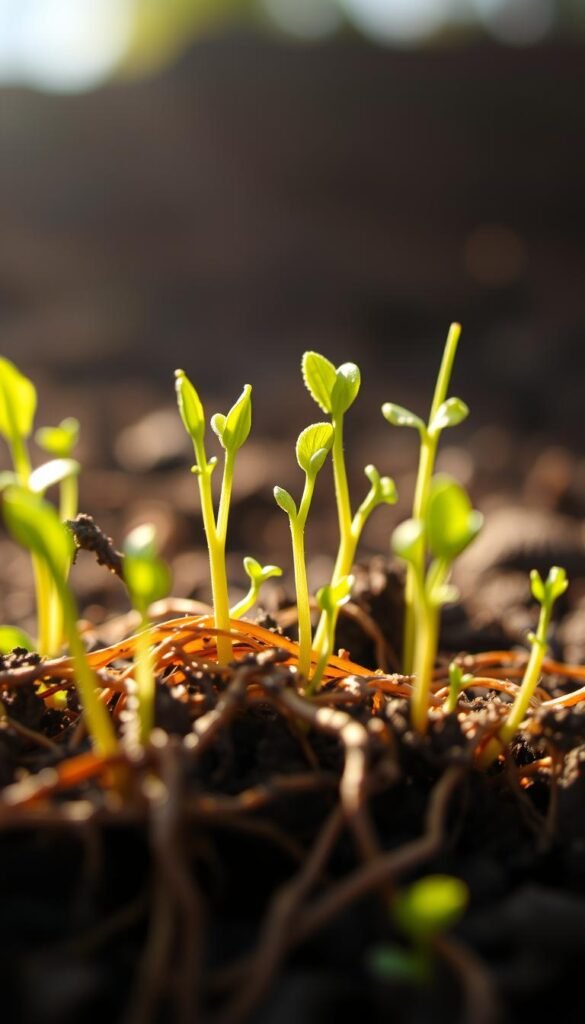
Strong roots create show-stopping blooms. Your garden’s success depends on choosing resilient varieties and understanding what happens below the soil line. Let’s explore how smart plant selection and root care work together to build thriving flower beds.
Selecting the Right Plants and Seeds
New gardeners thrive with tough performers like sunflowers and marigolds. These champions handle rookie mistakes while delivering vibrant color. Sweet peas and nigella add vertical interest with minimal fuss – perfect for that first step into gardening.
Always check plant tags before buying. Those colorful labels reveal crucial details:
- Sun symbols showing light needs (full sun = 6+ hours)
- Water droplet icons indicating thirst levels
- Mature height/width to prevent overcrowding
Group thirsty specimens near your rain barrel. Place sun worshippers where afternoon light lingers. This strategic pairing helps plants grow stronger with less effort from you.
Understanding the Importance of Healthy Roots
Robust root systems act like nature’s survival kit. They store nutrients, anchor against storms, and seek moisture during dry spells. Well-developed roots explain why California poppies flourish in poor soil while pansies bounce back after heavy rain.
“Nourish the roots, and the flowers will care for themselves.” – Master Gardener Linda Chalker-Scott
Your earlier soil work pays off here. That compost-rich earth lets roots spread freely, creating plants that resist pests and drought. When transplanting, gently loosen root balls to encourage outward growth. Healthy beginnings lead to seasons of color!
Essential Tools and Supplies for Flower Gardening
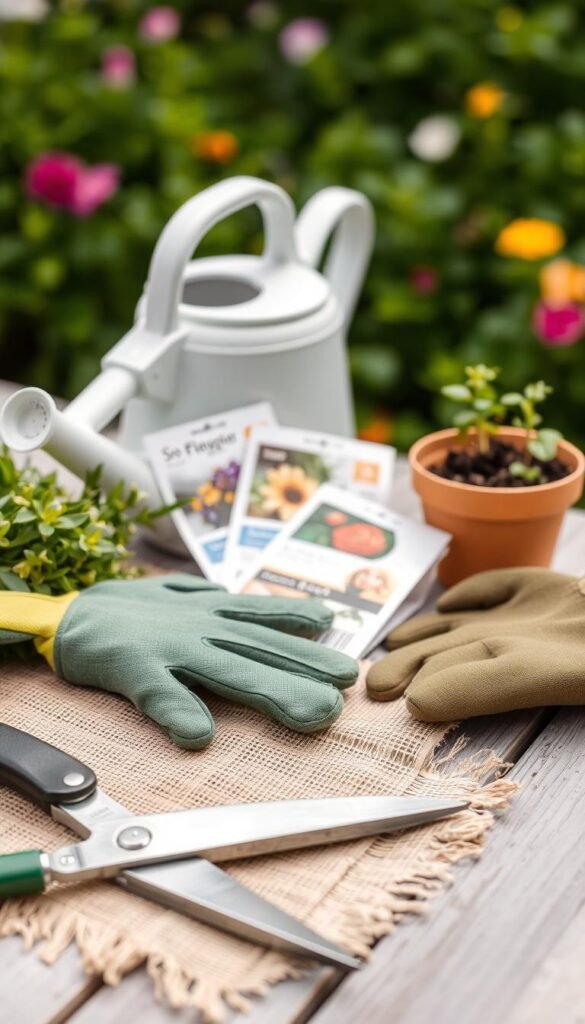
The right tools transform gardening from chore to joy. Quality equipment and smart supplies help your plants thrive while saving time and energy. Let’s explore what every green thumb needs for success.
Smart Tool Selection Saves Effort
Invest in these five workhorses first:
| Worth Splurging | Budget-Friendly | Comfort Add-Ons |
|---|---|---|
| Stainless steel trowel | Plastic seedling trays | Gel-padded knee mat |
| Ergonomic pruners | Bamboo plant markers | Wide-brim sun hat |
| Steel rake | Vinyl watering can | Breathable gloves |
Look for tools with lifetime warranties. They cost more upfront but last decades. Comfort items like kneeling pads make long sessions enjoyable.
Organic Boosters Feed the Earth
Compost acts like vitamin shots for your soil. Create your own bin with kitchen scraps and leaves. Many cities offer free compost – check local recycling programs.
Mulch does triple duty:
- Blocks weed growth
- Locks in moisture
- Breaks down into nutrients
Water Wisely With Drip Systems
Drip hoses deliver hydration straight to roots. They use 50% less water than sprinklers. Install tubing before planting to avoid disturbing roots later.
Morning watering reduces evaporation. Pair your system with a timer for carefree hydration. Your flowers will drink deeply even when you’re away.
Designing a Beautiful Flower Bed Layout
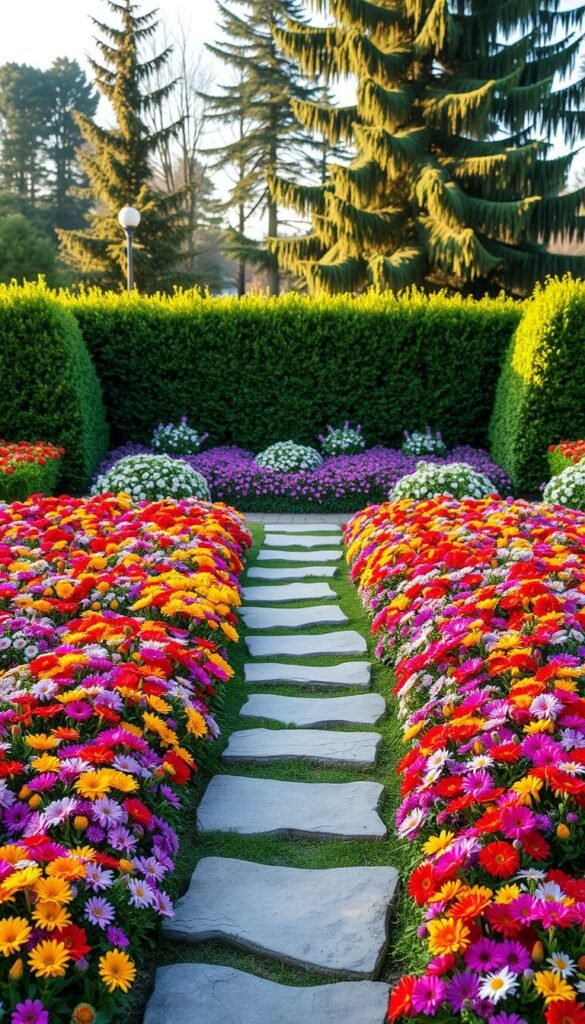
A stunning flower bed combines artistic vision with ecological awareness. Strategic design choices transform ordinary plantings into living tapestries that evolve through seasons. Let’s explore how thoughtful arrangements create both visual harmony and pollinator-friendly spaces.
Mixing Colors, Textures, and Heights
Create depth by pairing spiky salvia leaves with round zinnia blooms. Alternate warm reds with cool purples for eye-catching contrast. Try this winning combination:
- Feathery cosmos (back)
- Velvety petunias (middle)
- Spreading lobelia (front)
Break traditional height rules by letting Verbena bonariensis float above shorter neighbors. Group plants in odd numbers – three coneflowers or five black-eyed Susans create natural rhythm.
Planning for Continuous Seasonal Blooms
Keep color flowing from spring frost to fall’s first chill. Start with crocuses and daffodils, transition to daylilies, then finish with asters. Use this staggered approach:
| Season | Early Bloomers | Mid-Season | Late Performers |
|---|---|---|---|
| Spring | Tulips | Peonies | Iris |
| Summer | Coreopsis | Shasta Daisies | Phlox |
| Fall | Goldenrod | Sedum | Mums |
Deadhead spent flowers to encourage new buds. Leave some seed heads for winter interest and bird food. Your bed will remain dynamic while supporting local wildlife.
Tips for Successful Planting and Garden Maintenance
Timing transforms good gardens into great ones. Learn your local frost dates through agricultural extensions or weather apps – this knowledge becomes your seasonal compass. Proper scheduling prevents frost damage and ensures robust growth.
Best Practices for Planting in Spring and Fall
Start perennial seeds indoors 6-10 weeks before spring’s last frost. Transplant them outdoors when soil warms, typically 1-2 weeks after frost danger passes. For annuals like zinnias, begin indoor sowing 3-4 weeks earlier. Fall planting shines for bulbs – tuck tulips and daffodils into earth 6 weeks before ground freezes.
Controlling Weeds and Preventing Soil Compaction
Apply 2-3 inches of straw mulch to smother unwanted growth. Hand-pull weeds after rain when roots release easily. Avoid stepping on beds – use boards as temporary walkways. Loosen compacted areas with a garden fork every 4-6 weeks.
Mulching Strategies for Moisture Retention
Refresh mulch layers monthly during summer heat. Try shredded bark for perennial beds and grass clippings for vegetable plots. These materials:
- Reduce watering needs by 30%
- Maintain even soil temperatures
- Break down into nutrients over time
For vibrant color with minimal effort, explore easy-care annuals that thrive in various conditions. Water deeply before mulching – moist soil locks in hydration better than dry earth. With these techniques, your garden becomes a self-sustaining showcase.

